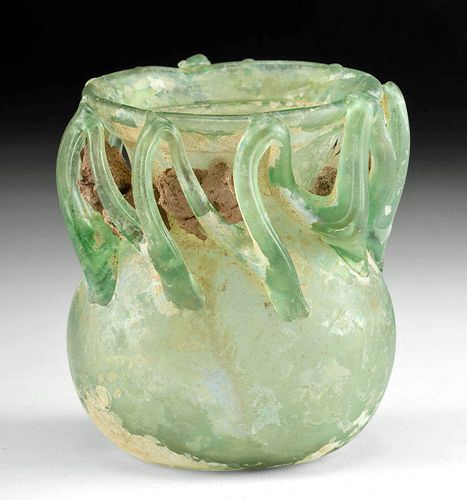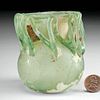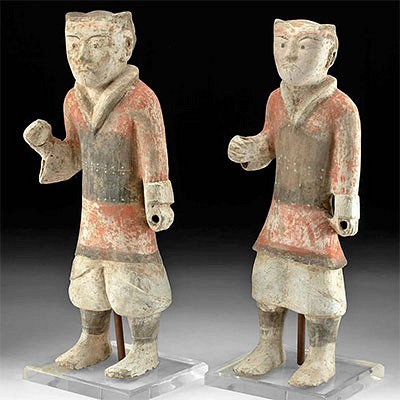Published / Exhibited Roman Glass Jar w/ Zigzag Trail
Lot 22
About Seller
Artemis Fine Arts
686 S Taylor Ave, Ste 106
Louisville, CO 80027
United States
Selling antiquities, ancient and ethnographic art online since 1993, Artemis Gallery specializes in Classical Antiquities (Egyptian, Greek, Roman, Near Eastern), Asian, Pre-Columbian, African / Tribal / Oceanographic art. Our extensive inventory includes pottery, stone, metal, wood, glass and textil...Read more
Categories
Estimate:
$1,500 - $2,250
Absentee vs Live bid
Two ways to bid:
- Leave a max absentee bid and the platform will bid on your behalf up to your maximum bid during the live auction.
- Bid live during the auction and your bids will be submitted real-time to the auctioneer.
Bid Increments
| Price | Bid Increment |
|---|---|
| $0 | $25 |
| $300 | $50 |
| $1,000 | $100 |
| $2,000 | $250 |
| $5,000 | $500 |
| $10,000 | $1,000 |
| $20,000 | $2,500 |
| $50,000 | $5,000 |
| $100,000 | $10,000 |
| $200,000 | $20,000 |
About Auction
By Artemis Fine Arts
May 25, 2023
Set Reminder
2023-05-25 10:00:00
2023-05-25 10:00:00
America/New_York
Bidsquare
Bidsquare : ON-SALE! Antiquities, Pre-Columbian, Ethno, Fine Art
https://www.bidsquare.com/auctions/artemis-gallery/on-sale-antiquities-pre-columbian-ethno-fine-art-12860
ON-SALE Antiquities, Pre-Columbian, Ethno, More! Artemis Fine Arts info@artemisfinearts.com
ON-SALE Antiquities, Pre-Columbian, Ethno, More! Artemis Fine Arts info@artemisfinearts.com
- Lot Description
Roman, Imperial period, Eastern Mediterranean, ca. 3rd to 4th century CE. A gorgeous jar free-blown from light green glass to present a thick trailing that zigzags between the shoulder and rim to form an openwork collar. The vessel displays a piriform body rising to a short cylindrical neck that gently flares to a folded rim. Finally, as the piece de resistance, thick undulating trails run from rim to the shoulder and marvelous silver and blue violet iridescence kisses the surface! Size: 2.8" Diameter x 3.3" H (7.1 cm x 8.4 cm)
Similar glass vessels can be found at the Corning Museum of Glass (74.1.26 and 53.1.6), Johns Hopkins Archaeological Museum (JHAM HT 127), and the Science Museum London (A54786).
Exhibited in “Ancient Glass: Selections from the Richard Brockway Collection” at the Hallie Ford Museum of Art at Willamette University, Salem from March 10 to May 19, 2007 and “Glass of the Ancient World” at the Vero Beach Museum of Art, Florida from October 11 to December 28, 2008.
Published in “Ancient Glass: Selections from the Richard Brockway Collection.” Hallie Ford Museum of Art at Willamette University, Salem, 2007; and “Glass of the Ancient World.” Vero Beach Museum of Art, Florida
Provenance: private Vero Beach, Florida, USA collection, acquired before 2003
All items legal to buy/sell under U.S. Statute covering cultural patrimony Code 2600, CHAPTER 14, and are guaranteed to be as described or your money back.
A Certificate of Authenticity will accompany all winning bids.
We ship worldwide and handle all shipping in-house for your convenience.
#177403Intact and excellent with rich weathering film, slight iridescence, and earthen deposits in areas. Pontil mark on underside of base. A pontil scar or mark indicates that a vessel was free-blown, while the absence of such a mark suggests that the work was either mold-blown or that the mark was intentionally smoothed away or wore away over time.Condition
- Shipping Info
-
All shipping is handled in-house for your convenience. Your invoice from Artemis Gallery will include shipping calculation instructions. If in doubt, please inquire BEFORE bidding for estimated shipping costs for individual items.
-
- Buyer's Premium



 EUR
EUR CAD
CAD AUD
AUD GBP
GBP MXN
MXN HKD
HKD CNY
CNY MYR
MYR SEK
SEK SGD
SGD CHF
CHF THB
THB














